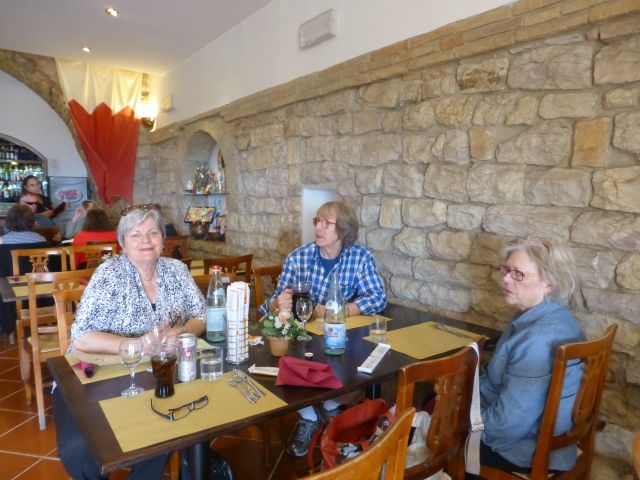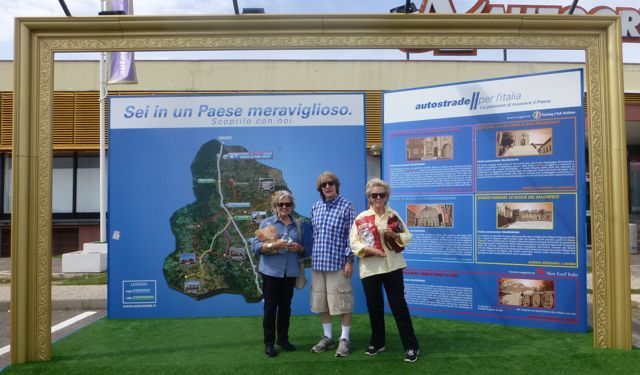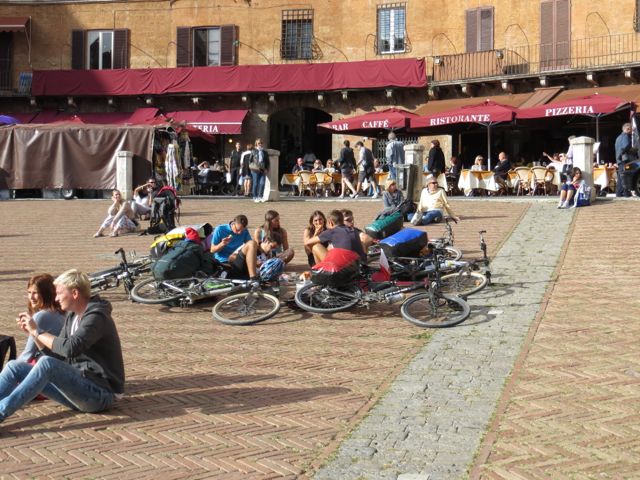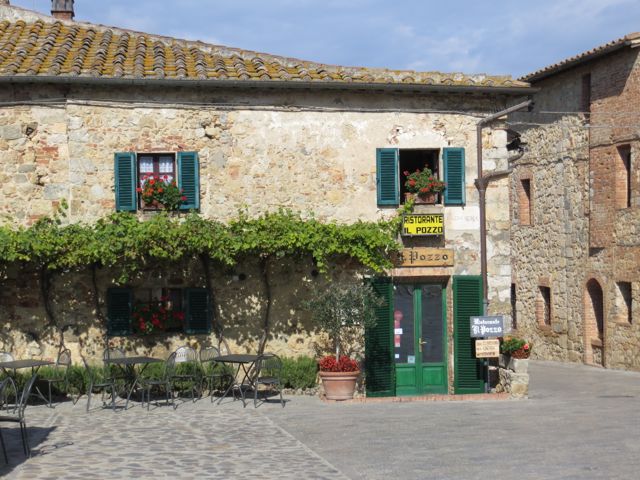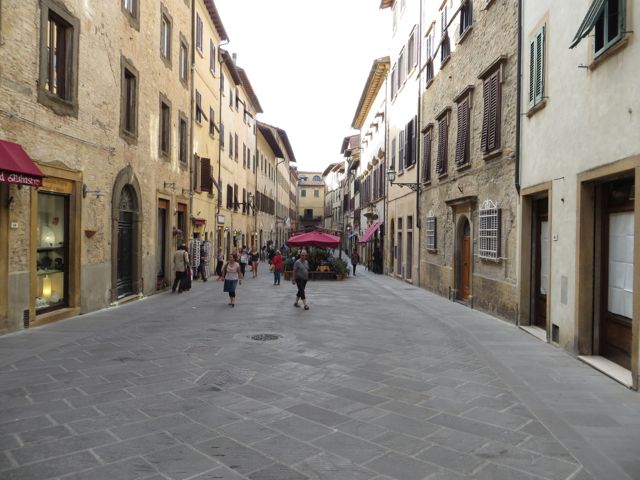Milan
 Hello from Italy. After three days in Milan we are now at the Castle in the Casentino, the castle, Castello Porciano, that we will talk about in the Medieval History class since it is important in the story of the Conti Guidi in the Middle Ages. So three days in Milan and then "hit the road"....to the Castle.
Hello from Italy. After three days in Milan we are now at the Castle in the Casentino, the castle, Castello Porciano, that we will talk about in the Medieval History class since it is important in the story of the Conti Guidi in the Middle Ages. So three days in Milan and then "hit the road"....to the Castle.
Milan is always such a delight since it shows you the Italy That Works. Modern creative busy Italy. Milan more than anything else is now the fashion capital of the world and that is very important in the international competition that now rages among the Europeans and the rest of the world. Fashion and clothes and making them and selling them is one of the best businesses you can have and the Italians have it best. They have pushed Paris out and now Milan is the winner! When you arrive at Malpensa Airport you sense it immediately. Well dressed people. The best sun glasses in the world....the SUNGLASSES!!! its hard to believe that they can make new ones new designs but all the time....something always new. Right now Ray Ban wins everything.
Ray Ban is on everyone. Really. Just almost everyone and they have a great big huge electric sign up over the Piazza del Duomo that says "Ray Ban" but all the thousands of young people in the piazza are saying the same thing: "Ray Ban!" And yes I know some of you are saying but Ray Ban is American! Yea, but not anymore. Ray Ban was bought by Luxotica in 1998, so it is now Italian as is almost every other major glasses maker. Luxotica is verging on a complete monopoly of the manufacture and sales of high end glasses.
So Milan. September. It rained a few days ago and the weather these three days has been the best weather I have ever seen in Milan. Ever. The sky is brilliant clear blue with rolling white clouds. The air is pure. The temperature has been perfect: 75 every day. And where to stay you ask? Well we have a favorite: Hotel Cavour.
Its an old "business" hotel," in other words, high quality catering to the the needs of hte business man and charging an appropriate price. Wonderful people to welcome you all with an old world charm; not too fancy, not too sparkling. And worth the price.
If you book on their website and pay in advance you get a huge price discount. The Cavour has everything. It has a famous breakfast that may not be equaled by many Italian hotels and I doubt equaled in Milan. All served in a beautiful dining room with waiters catering to your every need. Coffee, fruit, yogurt, eggs, toast of all kinds, pastries, fresh fruit, Sicilian blood red orange juice....and everything you want. Then in addition to the included breakfast, the hotel also has one of the best restaurants on the ground floor. Never crowded, quiet, and intimate, it allows you to eat right in the hotel which is so nice if you have just arrived and are tired from traveling and just want to eat. But the best thing I would say about Hotel Cavour is the location. It stands at Porta Cavour that you see above at the top of the page., That's the old north gate in the medieval walls of the city and the Porta marks the extent of the historic center of the city within which private car traffic is prohibited. Thus the Cavour is as close as you can get to the center and still drive up in front of the hotel without too much of a hassle. And if you have a rented car this is what you want. There are other hotels closer in, but they are harder to reach with a car. The Cavour stands right at the north corner of the fashion center of the city.
Via della Spiga runs along the north periphery of that gorgeous inner city neighborhood that houses many of the great fashion houses of Italy. Look at how elegant with the flowers and the shining windows: the most beautiful store windows in the world. Strolling along on a Saturday late afternoon with everyone all dressed up and ready to go out to dinner just has to be one of the great pleasures of Milan.
Leonardo and the Last Supper. We came to see Leonardo. So Friday morning we headed to Santa Maria delle Grazie to see, The Last Dinner, as our Taxi driver called it. We have been laughing ever since about that. Why is that so hilarious? But whenever we say it to any American they can't stop laughing: The Last Dinner. Its not the same is it?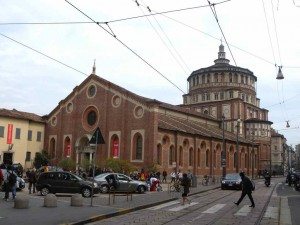
Anyway, we had our tickets all set for 10:30 AM. You must book ahead. No tickets sold at the door. All advanced reservations. It is all very well organized. You buy an appointment, each of which lasts 15 minutes. So we bought two...so we had 30 minutes. But we said afterwards, that we would book one hour the next time. It is just so overwhelming to be there and see it that it takes at least 15 minutes to adjust and begin to really engage with the great painting.
If you have read any of the books about the Last Supper and Leonardo, you know that it has gone through such a terrible series of preservation crises and moments of deterioration that you expect the real thing to be a pale ghost of a painting. But in reality it is not. It is magnificent and not disappointing. The twenty-year restoration by the great restorer Pnin Barcelon Brambilla is glowing with rich color and magnificent perfection. And the presentation in the very quiet air conditioned refectory is awesome. 25 people in each group. And a fairly reverent admiring group it was when we were there. If you are going to Milan and hope to see the Last Supper, read Ross King's wonderful book Leonardo and the Last Supper. It is a great book.
Also you want to visit the church. And while in the church make sure you find the door up on the left side of the high altar that takes you out into the Chiostro delle Aranci, the Cloister of the Orange Trees. It is one of the most beautiful places in all of Milan and it is where Leonardo worked as he planned and drew the Last Supper. When you sit here in the silence, with the occasional bells ringing and the gurgling of the water in the fountain you are taken back 500 years and can imagine Leonardo sitting there drawing one of the apostles.
Assisi
 Assisi is one of the busiest tourist cities in all of Italy. During the year millions (it used to be 2-3 million and now must be more) come here to this very small city every year. Assisi is very small. Just a few streets that cling to this sharply vertical hillside. The great fortress (Rocca Maggiore) stands at the top of the mountain and down below is the flatland. And that's it. So all the visitors are concentrated on these few streets that all lead to San Francesco, the church within which is buried the most famous Italian churchman of all time. (Neither Peter nor Paul were Italian!) It is not surprising that it is busy. It should be! But I worried that all the other visitors would ruin it for ME! Well I need not have worried. Our visit today was as perfect and rich and wonderful as any Italian city visit could have been. Yes there are lots of visitors. But! But the city is so well organized so ready for visitors, so clean, so welcoming, that it all works fine. We all loved it. Dagmar from Monday class and sister Patricia and our other friend Peggy Carlisle who was with us last year, all four of us just loved every minute. Here I am planning our walks. As you can see, I am all dressed up in my professor's costume.
Assisi is one of the busiest tourist cities in all of Italy. During the year millions (it used to be 2-3 million and now must be more) come here to this very small city every year. Assisi is very small. Just a few streets that cling to this sharply vertical hillside. The great fortress (Rocca Maggiore) stands at the top of the mountain and down below is the flatland. And that's it. So all the visitors are concentrated on these few streets that all lead to San Francesco, the church within which is buried the most famous Italian churchman of all time. (Neither Peter nor Paul were Italian!) It is not surprising that it is busy. It should be! But I worried that all the other visitors would ruin it for ME! Well I need not have worried. Our visit today was as perfect and rich and wonderful as any Italian city visit could have been. Yes there are lots of visitors. But! But the city is so well organized so ready for visitors, so clean, so welcoming, that it all works fine. We all loved it. Dagmar from Monday class and sister Patricia and our other friend Peggy Carlisle who was with us last year, all four of us just loved every minute. Here I am planning our walks. As you can see, I am all dressed up in my professor's costume.
You can see that the streets are well marked and you can walk around without any map. It is all there for you to find. And a word about the streets. They are so clean. I would say that Assisi is the cleanest Italian city I have ever seen. They must be cleaning constantly since the number of visitors is so huge. And no graffiti. It is hard to believe since I am so accustomed to it everywhere, but here in St Francis' city there is no graffiti. Either they run out and clean it immediately OR the graffiti artists don't like Assisi. In any case, it has a very positive impression. You just feel better and appreciate a whole day with no hideous words on the medieval walls. Rome is full of it. Florence is full of it. Venice is full of it. But Assisi is clean.
We started our visit in Piazza Santa Chiara and I recommend it as a good way to start. It is not in the center but rather somewhat to the eastern edge of the city and thus a little quieter. And of course there is Saint Clare's wonderful church in front of you.
Just down the street from Santa Chiara we found a wonderful little restaurant in the Hotel Belvedere. When we walked in there was no one there. So we almost lost our commitment. But the staff was so welcoming and so we went in and sat down and had a just really great lunch. Here we are at our table in the lovely old medieval dining room, with Dagmar there on the left, me, and Peggy on the right. Sister Patricia took the photo. And the hilarious part of it was that the minute we entered and sat down about 1000 more people followed us into the place and soon it was packed....well full....a lot of diners.
And we had a fantastic lunch at a shockingly low price. So our first meal in Assisi was just great. A big success and we made some new friends. The little Hotel Belvedere would be a good place to stay if you wanted to stay right in the town. We had planned all along to go outside to a country villa about which more later. But the little hotel was very cheap: about 70 euros a night. That is great. Especially in the center of Assisi. Here I am after the meal, relaxing against the cool stone wall.
Now back to the center of the city. Here we are looking west into the heart of the city and towards the western end where you find the star attraction of Assisi: the church of San Francesco. Everyone is here to visit San Francesco.
And here we are walking down the hill and into the piazza of the Basilica di San Francesco. The church sits all by itself on the top of a spur that juts out and leaves the basilica sitting high and visible from all over the valley. The gorgeous pink stone shimmers in the September sun.
Here is another shot of San Francesco taken from a hilltop northwest of the church. This photograph by Dagmar is one of the most beautiful I have ever seen of San Francesco, and you can see how it sits all alone up on its hill with nothing behind it or around it. The pink stone against the green hills and blue sky is so beautiful. All of the town is beyond it to the east along the hillside. No building has been allowed up around the church and nothing below it. The valley below is a long park along a little stream.
Here we are inside the main upper church along with other visitors. You are allowed to take photos as long as no flash. Most people followed the rules. This is the part of the church that had the catastrophic collapse in the earthquake over the high altar. It has all been repaired.
The most memorable and emotional part of the visit is the descent into the tomb chapel of Saint Francis. It is a small space and when we came down into it, it was quite full with nuns and Franciscan monks and visitors on their knees, and total silence. The whole space was almost hypnotic in the sense of reverence and power of the saint and the power of his life's work. Some people knelt right against the tomb screen with their heads up against the protective panel crying. I saw a mother and daughter, holding hands and crying as they remembered, I am sure, a husband and father. They stayed for a long time and then walked out in silence. It is an amazing place. To which people come to remember an amazing man.
And now here we are on our way again: stopping at an AUTOGRILL celebrating Italy!
Perugia
So here we are in this fascinating hilltown in central Italy which is very close to Assisi. Here is a view of the city that allows you to see how it is built, one building on top of another on top of another making steps all the way up the hill.
So what is so special about Perugia? Well it is the biggest of all the cities we will visit during our winter lecture series. In fact, it is one of the biggest of all central Italian cities, much bigger than Siena and a rival for Florence. But in addition to size, it has something else: a great mixed economy that includes major food industry giants like Perugina, a huge university, and the biggest university for foreign students in Italy and of course tourism too. But Perugia is much less dependent on tourism than Florence is. The university for foreign students specializes in teaching Italian and has been doing it well for one hundred years. People all over the world know about the University per Stranieri di Perugia. Unfortunately, in the recent years it has been most famous for the Amanda Knox trial that dragged on for years and years during which the American student Amanda Knox spent years in jail. She was unjustly accused of murder and spent time in jail awaiting and then living through the very long trial. It is an incredible story and has had a very negative impact on the reputation of Perugia in the eyes of parents of prospective students. If you want to read her story get her book. It is an amazing journey. But back to Perugia. Where is it? It sits high up on the Apennine mountains, half way between Rome and Florence. It was one of the most important Etruscan towns in the years before Rome conquered the whole peninsula. Then after the Roman conquest Perugia continued to be an important anchor for Roman rule. In the Renaissance it was part of the Papal states and thus great papal families like the Borgias made it one of their capitals and lavished money on art and architecture. Both Lucretia and Cesare Borgia lived here.
Here is the center of Perugia: The Corso Vanucci, the center of everything. Food. Shopping. Chocolates. The Cathedral. The Art Museum.
This great thoroughfare has been the center of the city for a thousand years and more. It runs right along the top of the mountain. And all of the rest of the city straggles down the hillside along a hundred little streets that descend the mountain, each of which creates its own special little wandering neighborhood. Here, take a little walk down the hill on Via del Morone, one of the most interesting. Look at all the shops and the side streets and the little piazzas. Bookstores. Foodstores. Ethnic..one of my favorites called "Etnico." Love that Ethnic. Little alleys. Little gardens with flowers exploding over the walls. Pizzerias. Cafes. 
And then at the bottom of the hill, everything suddenly levels out and a hundred little garden piazzas and churches greet you in these tranquil plains. Or better would be to say "shelves" since the descent is not over. You still have a way to go. Here you see one of the gems: the Oratorio of San Bernardino next to the great church of San Francesco with a big green lawn that is the favorite gathering place of Perugian lovers and gymnasts and motorcyclists and tourists who are totally puzzled by the show.
 There is so much more to tell you about Perugia.
There is so much more to tell you about Perugia.
Orvieto
Orvieto is a sort of magical floating island. It floats above the Tiber river valley on a table top, 1000 feet above the valley below. The whole city spreads across this volcanic eruption that provided both a 100% safe and secure location but also very special building materials from the volcanic rock that forms it. Thus the city very early on had not only the protection of the high location, but also the protection of solid rock walls that made the city totally impregnable. Enemies could not conquer it because it not only had a great location but it also had its own water supply. Here it sits like a land of golden angels dancing above the heads of the mortals below. Look at the great high tufa walls with the Cathedral shimmering in the setting sun.
The center of the city is one of the most beautiful cathedrals in all of italy. The facade has a brilliant architectural balance, shining mosaics up at the top, and and a sculptural program carried out by the architect Lorenzo Maitani. Here you see it from the little street right in front of the church and this tight street has always created great photos of this beautiful facade.
And the inside is also a masterpiece of Italian Gothic architecture.
Our visit to Orvieto was made so much better by accidentally turning up this tiny little street called Via dei Magoni and stopping at the weaving shop of Maria Gagliano.
Maria weaves some of the most beautiful things you will ever see. Here she is in her shop with her loom in the corner.
And as we talked and shopped we ask her about where to have lunch and fortunately there was a great place right up her street: Trattoria La Pergola, a family run restaurant founded by grandfather Enrico Materazzo and now of many generations with all the generations working in the restaurant. It has a wonderful welcoming atmosphere with a beautiful garden all enclosed and private, but full of flowers and plants. Here we are in Via dei Magoni about to enter La Pergola. You Can see that sister Patricia and Peggy are loaded down with purchases from Maria's loom.
Here is the inside of La Pergola. You have to remember this little street and these great stops on Via dei Magoni for your own visit to Orvieto. The whole afternoon was so much better for knowing Maria and La Pergola. The food was fabulous and very reasonably priced.
But the fun was watching all the people and the Materazzo family as they handled the questions and comments. The place was full of Orvitani; locals, and that is always the proof of excellence. Here is the Materazzo grandson giving an agitated reply to some food question.
There is so much more to tell you about in Orvieto, but you will have to wait until February for the rest of it. Goodbye to Orvieto.
Siena
Siena is the Campo. Campo means field. Like our word "campus." And the center of Siena is this great big field which now is maybe the most beautiful urban piazza in all of Italy. This is the Campo as seen from up high over the cathedral.
What makes the Campo so beautiful is that it was formed into a fan-shaped half circle with magnificent paving divided into nine sections, each section of which represented the nine parts of the city, nine neighborhoods. These neighborhoods in the Middle Ages had a representative on the city council. So the shape and design of the Campo has symbolic meaning in that it says: "Siena governs itself; Siena has citizens who govern; Siena has neighborhoods that govern all of us."
But also it is just beautiful. And as well as symbolizing the self-government, and being beautiful, it is a sort of "living room" of Siena. Everything happens in the campo all day. And one great way to begin a visit to Siena is to go eat your mid-day meal (pranzo) at Al Mangia, the best restaurant in the Campo. And that is what we did today on our visit. Here you see Patricia and Peggy coming out of Al Mangia after a really great Pranzo. (I know the sign says Brasserie and Bar, but it really is a full service very high quality family run restaurant .)
The great advantage of Al Mangia (besides great food) is its position which allows you to occupy one of the forward tables and eat and enjoy the passing Campo scene. Here are just a few examples of all the fun today when we ate there.
First: Bikers!
Second: different kind of bikers!
Third: happy couple!
And finally: the whole magnificent scene. Look at those beautiful facades, the red brick in the golden setting sun over the Campo. And the whole piazza slopes down from a high point down down down to the front of the Palazzo Communale, thus creating a natural amphitheater. Come hear more about Siena on March 7 and March 8, 2015.
Volterra
 Volterra sits almost 2,000 feet above the western hills of Tuscany. The trip up to the top of the mountain is breathtaking and it raises your excitement as you go up up up.
Volterra sits almost 2,000 feet above the western hills of Tuscany. The trip up to the top of the mountain is breathtaking and it raises your excitement as you go up up up.
The high mountain-top location was discovered by pre-historic dwellers before the Etruscans as a perfect, safe place for a community. The Etruscans made it one of their most important cities, it was later conquered by the Romans, and was revived as a medieval commune and later a Florentine-dominated city of the Renaissance. And now in the twenty-first century it is one of the most popular tourist visits even though it is a far trip off of the main north-south route from Florence to Rome. There is no fast way to get there. You must wind your way through some of the most beautiful countryside of Tuscany. So the trip is total pleasure but you must be ready for various surprises and some delays. Here is one:
That's right: A Sheep Crossing. We were zipping down the road and slammed on our brakes along with the other cars and wondered what is going on and then there they were, happily baa baaing across the road. Notice they used the CROSS WALK!!!! Dont you love it? They are crossing in the cross walk with lighting for I assume Volterra farmers out for a walk late at night who need lights to cross the country road. But whatever, they were happy sheep off to make their Pecorino cheese that you cannot even imagine until you taste it freshly made here in Tuscany. And here they were just merrily off across the meadows as happy as a little sheep can be with a set of beautiful Tuscan sheep herder dogs helping guide them along. Pyrenees Mountain Dogs. White. Gorgeous. Almost as big as their sheep charges. That's him in the foreground of my photo. You know, I was so transfixed by this vision that I sat there watching and not thinking and all along my sister is yelling: "Get a photo; Get a photo!!!!!!!".......almost lost my chance.
The countryside here in this part of Tuscany is magnificent. Rolling hills, vineyards, olive orchards, grain, flowers, farm houses. It is like some Piero della Francesca landscape. It is softer than the rougher Chianti country. And the beauty of the countryside I would say, is one of the best reasons to make the trip to Volterra. But to enjoy it you have to rent a car. It just isnt as much fun on a bus. But you can do it on a public bus transportation.
And the trip can include some other charming stops that are there to enjoy along the way. One of my favorite places is Monteriggioni. This tiny town is one of few medieval towns of Tuscany to have preserved all its original walls.
So when you go into the gate of Monteriggioni, you find yourself inside a completely enclosed charming little town with a beautiful church and a wonderful restaurant: Il Pozzo.
And now let us go back to Volterra to the central piazza of the town.
And here we are in the very center of Volterra in front of the central palace of government. The building has a nice little museum with the best part of it the option to climb to the top of the tower you see. When you get up there, there is one of the greatest views of all of western Tuscany because you are already at the top of a high mountain and then you climb to the top of the tower at the top of the palace at the top of the town. The tower is not very big or thick so when you get up there you really can feel the power. I don't dare show you my photos for fear you will all get vertigo! They have a very thorough warning posted for all to read before you climb the stairs. And it lists all the diseases and problems that you should check first before climbing the stairs. Am surprised they do not have a doctor standing by to do an examination on each prospective hiker. One warning is: ha, I love this: "fear of heights!"....isn't that great. As if you have to be warned. Narrow stairs and scary high places. Want to go?
Volterra is a fantastic small city. They have closed most of the historic center to all cars and motor scooters. So many streets like this one are quiet and full of shoppers walking slowly and children playing and people pausing at cafes. It reminds me of Venice in the best way; quiet piazzas with no cars and with only the sound of people's voices laughing and enjoying the quiet lovely city. Now don't get me wrong; it is full of tourists too at certain hours and certain times. But in late September it was paradise. Just perfect. Busy. Yes. But a nice kind of busy. Fabulous shops. Wonderful restaurants. Come hear more on Jan 3 and Jan 4, 2015.


